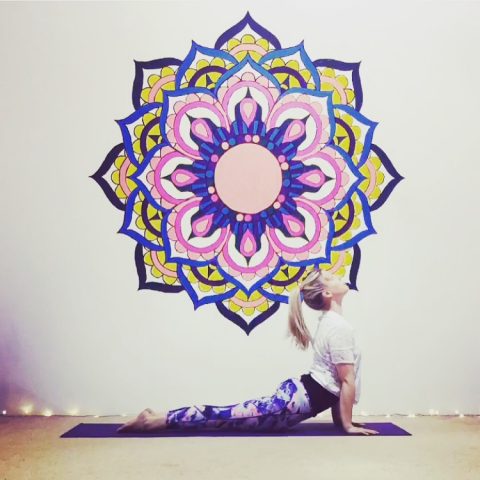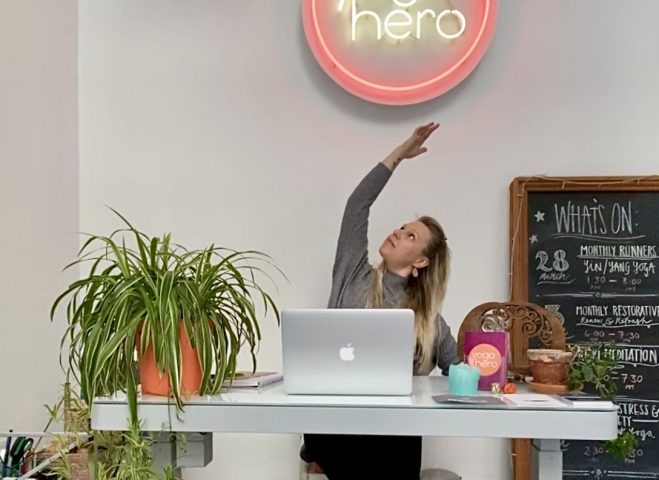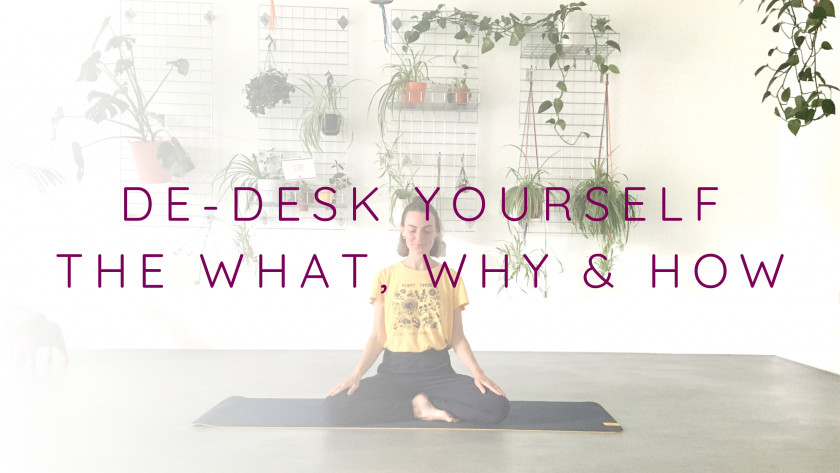In this blog post, we explore why tension in the neck, shoulders and upper back is so common, the impact of the tension, and you we can do to de-desk yourself (hint: you don’t need to be able to touch your toes!)
First of all, there’s no judgement here. Desks and chairs most definitely serve a purpose and are not the enemy. But, that said, it’s important to increase your awareness of your posture, the impact your desk posture has on your physical and mental state, and simple, practical things you can do to de-desk yourself.
Ok, so, once again, there’s NO judgement – but – let’s just be pragmatic and honest – most people tend to sit kind of slouched in their chairs, with the head forward of the body, shoulders hunched and rounded forward, working on stressful projects with looming deadlines, without doing much to de-desk.
Sitting like this causes an incredible amount of strain to the muscles of the neck, which are effectively engaged to hold the head in that – quite unnatural – position. Let’s bear in mind, that the neck isn’t really designed to hold this position for long periods of time.
Add to this that the arms are likely reaching forward, say, to a keyboard, which pulls the shoulders forward, which rounds the upper back and causes the chest area to tighten. This impacts on our ability to breathe deep (which is absolutely top top top priority in feeling energised, focused, and managing stress levels).
Add to THIS that there’s usually an element of stress going on here as well. Without getting too much in to the detail of stress here, in short, it causes the to muscles be tense – ready for action. So, the neck muscles are weight-bearing a long period of time AND tense too. The chest muscles become tight because they’re not getting any opportunity to lengthen. The spinal muscles also become tight from the added load of the head projecting forward. Last bit of doom and gloom here (sorry), everything listed above compounds on everything else listed above, so the stress compounds the negative effects of poor posture, and the poor posture further compounds the stress. There’s actually a ton more we could say about this, but, really, this is as much as is important for right now.
What can we do about it?
In short, there’s two things to focus on:
- Breathing
- Movement
That’s it. It you can focus on bringing these two things in to your day (more), you’ll counter the effects of desk posture and likely, hopefully, relieve postural discomforts. Just a note here – which you’ll already know but we really have to say it – if you’re experiencing ongoing pain or discomfort, find a good physio or osteopath to help. If you’re in/near Leeds and want recommendations, just get in touch with us. And also the information and advice in this blog is not – in any way – medical advice. Please see your physician for individual advice for you.
Ok.
So, with the promise that you’ll listen to your body, stay mindful and present and you’ll contact a licensed physician about any discomfort or pain, we’re in a good place to start to de-desk yourself.

De-desk yourself with: Breathing
Most people breath in to the top third of their lungs; the area around the collar bones. But the lungs go as low in to the torso as the ribcage. (Gently) Feel where your lowest ribs are (might be tickley!) – that’s how low your lungs go. I have found that aiming to breathe in to this area helps someone naturally find the posture that will help them sit at a desk in the most efficient and beneficial way. There’s so much on the internet (potentially available from your HR department at work) about having this degree bend in the knees and hips, and having your screen level with such and such a part of your face… This is important to know and review against your own work or working from home set up.
That said, for our purposes, I really find that most people intuitively sit tall and straight(er) when prioritising taking deep breaths in to the bottom of their lungs. Try it! Place your hands lightly on your lowest ribs again, and allow the low ribcage to expand in to your hands – for many people – having this tangible place to breathe into really helps, especially at first.
You’ll hopefully, maybe, find that your spine grew a little taller. Or maybe a lot taller! To allow the breath to get down in to the full lung. You maybe found that the breath was longer – pivotal in managing stress. You maybe found that your shoulders are more level with the chest now, rather than forwards of the chest… You maybe feel, brighter? A touch more energised?
Just a word here to keep in mind; we don’t want to go too far ‘the other way’ and hold the posture there; i.e. we’re not pulling the shoulderblades together, we’re not moving the spine in to a backbend shape, as this posture held for long periods of time would have it’s own issues. There’s a happy medium, which you’ll find over time. In the meantime, as often as you can, sit tall and breathe deep, into your hands if you need to. And combine this with…
De-desk yourself with: Movement

The human body is designed to move. You know this, because when move after sitting still for long periods of time, you’ll intuitively roll your shoulders, or stretch your arms over your head. You see it on planes, or trains all the time, when someone stands up after a period of being seated, they put the hands in the small of their back, draw their elbows backwards, send the hips forwards and probably groan, aaaaahhhh.
This is the body’s natural way of releasing the mechanisms it had put in place to help that person hold their position, their seated position, for all that time, to save energy. (The connective tissue, if you’re interested!)
So, get up from your desk regularly, and introduce de-desk yourself movement while you’re at your desk.
While you’re proofing an email, could you do this whilst gently twist in your chair? When you’re waiting for something from a colleague, could you gently roll your head from shoulder to shoulder. While you’re typing, at the end of a paragraph, could you make soft fists and draw circles with the fists to get the blood moving…
And then, set reminders if you need to, to get up at least every hour (this is completely arbitrary but it’s a decent place to start!) You could go to the loo, go to the printer, make a cup of tea, go talk to a colleague, not least go for a walk, look out of the window, etc etc etc etc.
We have to move; for the connective tissue, for ALL of the systems of the body, for muscle and bone health, for our mental capacity and health. We have to move.
And in an ideal world, you’ll – in your mornings, evenings, weekend – do some targeted de-desking movement, such as (yes you guessed it!) yoga. Running is an incredible activity with untold benefits, but it does exacerbate some of the issues that come from desk work, so just couple up running with yoga, and / or some targeted stretches and strengtheners – we can help explain this more if this sounds like you.
We have plenty of resources to help with de-desking yourself, and we’d love to help if you have any questions. And remember – don’t stress. Desks are not the enemy. We can combat this with awareness, and with a few – even small – changes to our days.
Thanks for reading!
Useful resources to De-desk yourself:
Yoga for Neck, Shoulder and Upper Back Relief
In-studio workshop, with Sinead
Friday 21.01.22, 19:15 – 20:30
£15 / inc in membership
https://yogahero.co.uk/event/studio-yoga-for-neck-shoulder-and-upper-back-relief/

